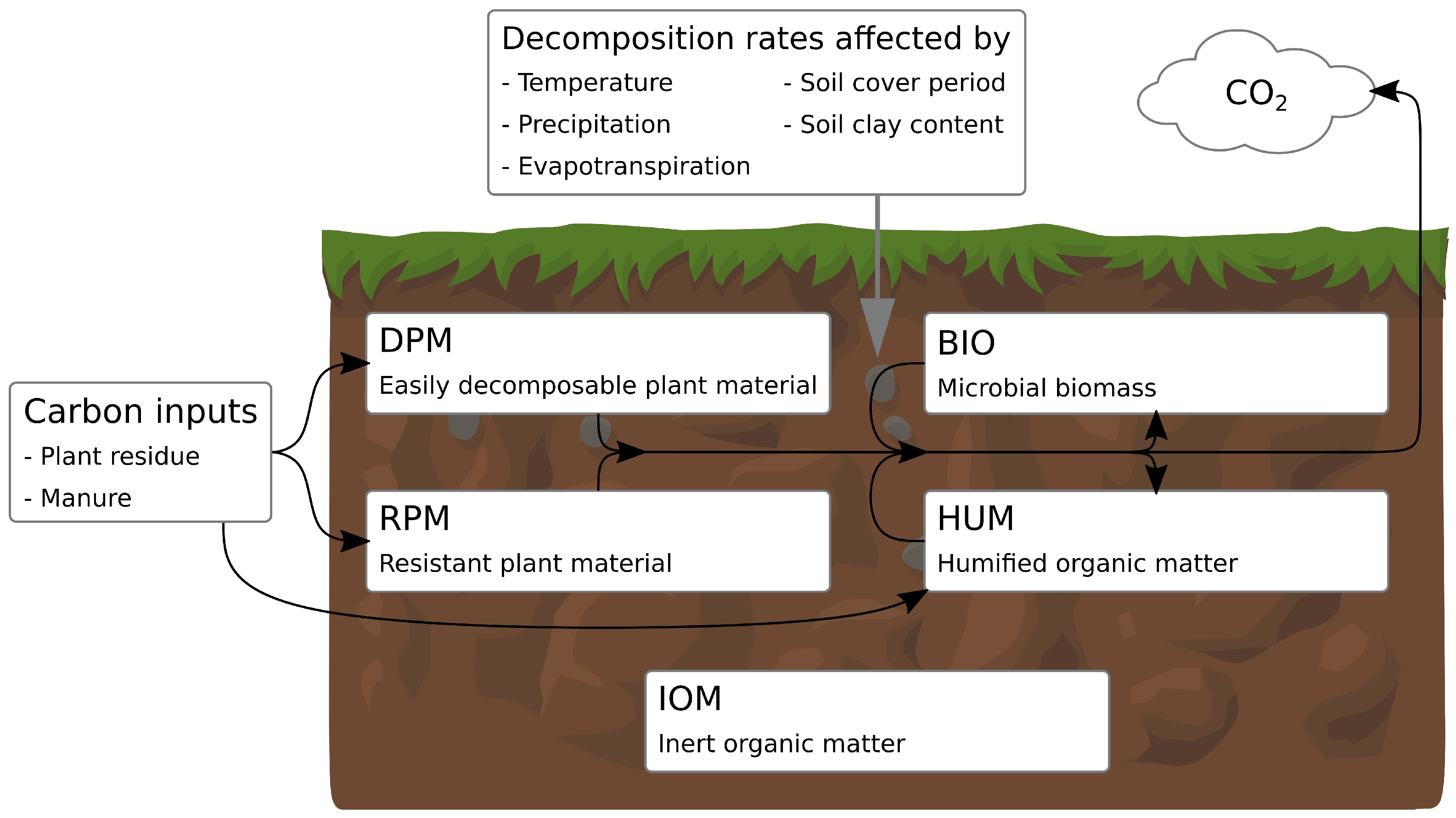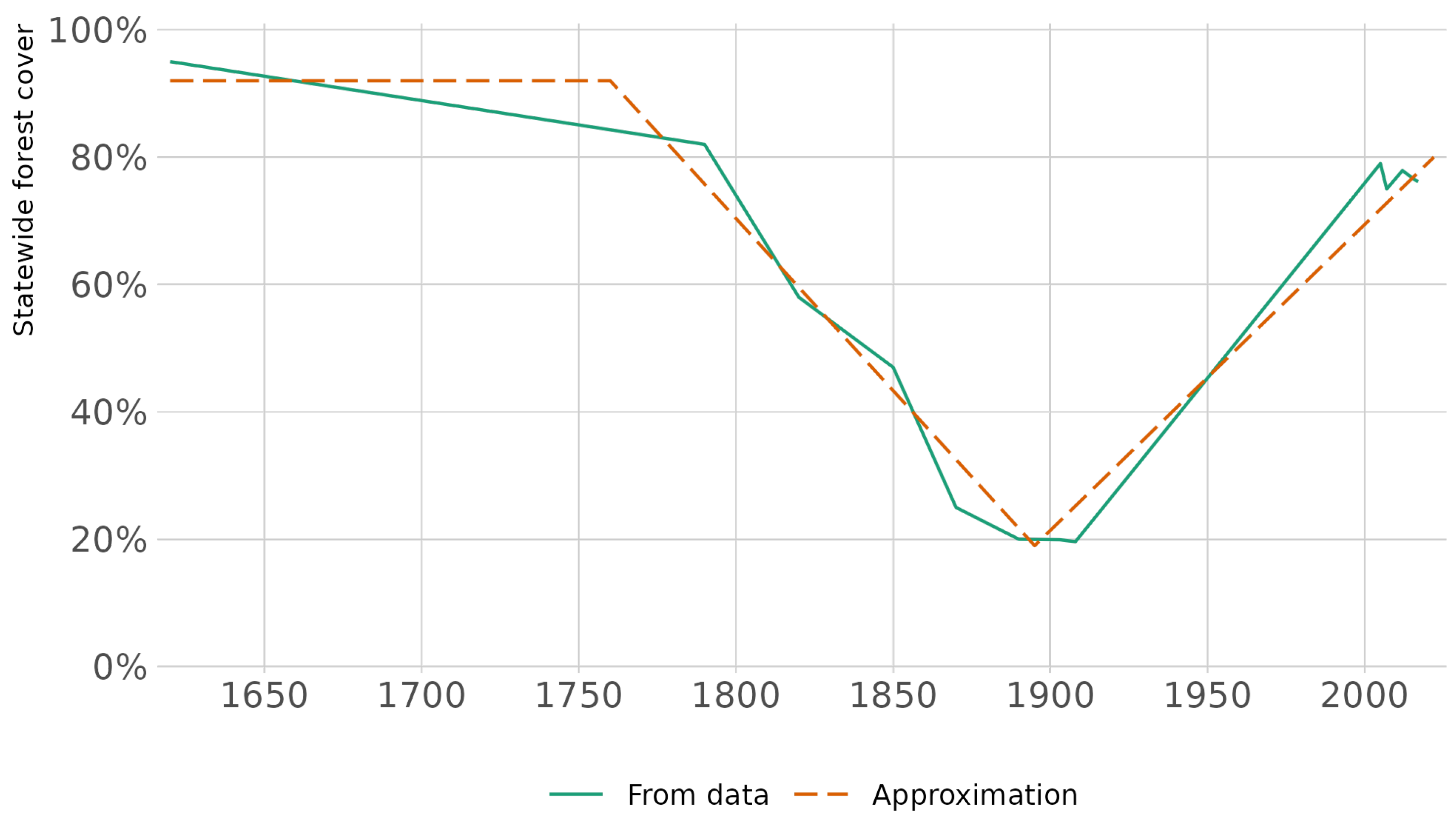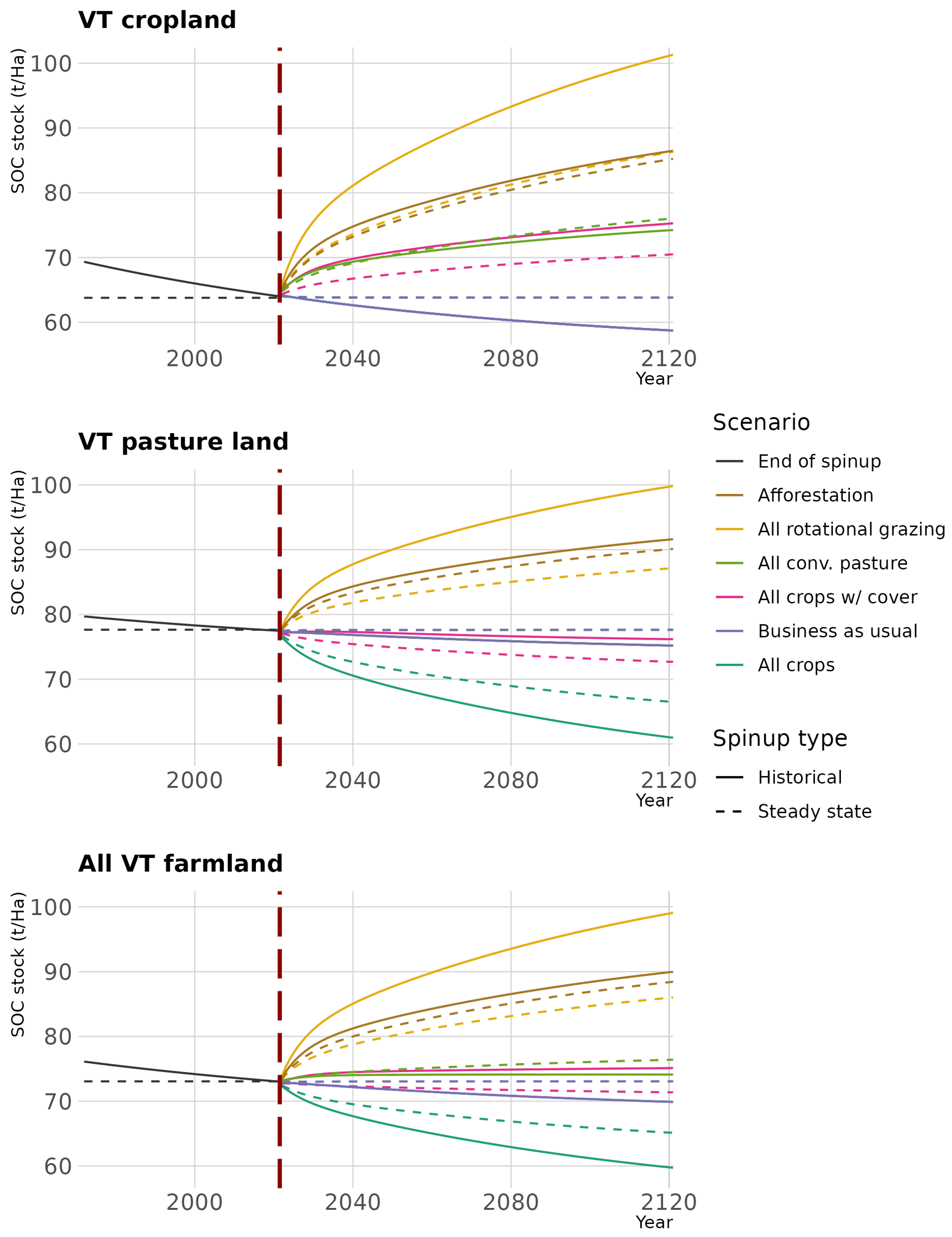A Historically Driven Spinup Procedure for Soil Carbon Modeling
Abstract
1. Introduction
1.1. Existing RothC Spinup Procedures
1.2. Objectives
2. Materials, Methods, and Results
2.1. RothC Model
2.2. Land Use History of the Study Area
2.3. Data Sources and Curation
2.4. Evaluation of Spinup Procedures
2.4.1. Steady-State Spinup
2.4.2. Historical Spinup
2.4.3. Imputed C Inputs for Each Spinup
2.5. Simulation Results
3. Discussion
Limitations
4. Conclusions
Author Contributions
Funding
Data Availability Statement
Acknowledgments
Conflicts of Interest
References
- Oelkers, E.H.; Cole, D.R. Carbon Dioxide Sequestration A Solution to a Global Problem. Elements 2008, 4, 305–310. [Google Scholar] [CrossRef]
- Ontl, T.A.; Schulte, L.A. Soil Carbon Storage. Nat. Educ. Knowl. 2012, 3, 35. [Google Scholar]
- Wiltshire, S.; Beckage, B. Soil carbon sequestration through regenerative agriculture in the U.S. state of Vermont. PLoS Clim. 2022, 1, e0000021. [Google Scholar] [CrossRef]
- Wiltshire, S.; Beckage, B. Integrating climate change into projections of soil carbon sequestration from regenerative agriculture. PLoS Clim. 2023, 2, e0000130. [Google Scholar] [CrossRef]
- Lal, R. Soil Carbon Sequestration Impacts on Global Climate Change and Food Security. Science 2004, 304, 1623–1627. [Google Scholar] [CrossRef]
- Lal, R. Carbon sequestration. Philos. Trans. R. Soc. B Biol. Sci. 2008, 363, 815–830. [Google Scholar] [CrossRef] [PubMed]
- Paustian, K.; Lehmann, J.; Ogle, S.; Reay, D.; Robertson, G.P.; Smith, P. Climate-smart soils. Nature 2016, 532, 49–57. [Google Scholar] [CrossRef] [PubMed]
- Coleman, K.; Jenkinson, D.S. RothC-26.3–A Model for the turnover of carbon in soil. In Evaluation of Soil Organic Matter Models; Powlson, D.S., Smith, P., Smith, J.U., Eds.; Springer: Berlin/Heidelberg, Germany, 1996; pp. 237–246. [Google Scholar] [CrossRef]
- Klumpp, K.; Coleman, K.; Dondini, M.; Goulding, K.; Hastings, A.; Jones, M.B.; Leifeld, J.; Osborne, B.; Saunders, M.; Scott, T.; et al. Soil Organic Carbon (SOC) Equilibrium and Model Initialisation Methods: An Application to the Rothamsted Carbon (RothC) Model. Environ. Model. Assess. 2017, 22, 215–229. [Google Scholar] [CrossRef]
- Falloon, P.; Smith, P. Simulating SOC changes in long-term experiments with RothC and CENTURY: Model evaluation for a regional scale application. Soil Use Manag. 2002, 18, 101–111. [Google Scholar] [CrossRef]
- Bolinder, M.; Janzen, H.; Gregorich, E.; Angers, D.; VandenBygaart, A. An approach for estimating net primary productivity and annual carbon inputs to soil for common agricultural crops in Canada. Agric. Ecosyst. Environ. 2007, 118, 29–42. [Google Scholar] [CrossRef]
- Skjemstad, J.O.; Spouncer, L.R.; Cowie, B.; Swift, R.S. Calibration of the Rothamsted organic carbon turnover model (RothC ver. 26.3), using measurable soil organic carbon pools. Soil Res. 2004, 42, 79–88. [Google Scholar] [CrossRef]
- Weihermüller, L.; Graf, A.; Herbst, M.; Vereecken, H. Simple pedotransfer functions to initialize reactive carbon pools of the RothC model. Eur. J. Soil Sci. 2013, 64, 567–575. [Google Scholar] [CrossRef]
- Sierra, C.A.; Mueller, M.; Trumbore, S.E. Models of soil organic matter decomposition: The SoilR package, version 1.0. Geosci. Model Dev. 2012, 5, 1045–1060. [Google Scholar] [CrossRef]
- Serge, W.; Sarah, G.; Brian, B. Github Repository for R Code Used in This Paper. 2023. Available online: https://github.com/brianbeckage/SoilCarbonSpinupPublished (accessed on 19 January 2023).
- Zimmermann, M.; Leifeld, J.; Schmidt, M.W.I.; Smith, P.; Fuhrer, J. Measured soil organic matter fractions can be related to pools in the RothC model. Eur. J. Soil Sci. 2007, 58, 658–667. [Google Scholar] [CrossRef]
- Jenkinson, D.S.; Andrew, S.P.S.; Lynch, J.M.; Goss, M.J.; Tinker, P.B. The Turnover of Organic Carbon and Nitrogen in Soil [and Discussion]. Philos. Trans. Biol. Sci. 1990, 329, 361–368. [Google Scholar]
- Kuzyakov, Y.; Friedel, J.K.; Stahr, K. Review of mechanisms and quantification of priming effects. Soil Biol. Biochem. 2000, 32, 1485–1498. [Google Scholar] [CrossRef]
- Klyza, C.; Trombulak, S. The Story of Vermont: A Natural and Cultural History, 2nd ed.; University Press of New England: Hanover, NH, USA, 2015. [Google Scholar]
- Merck. History of Vermont Forests & Farmland. 2018. Available online: https://www.merckforest.org/history-of-vermont-forests-farmland/ (accessed on 24 March 2022).
- Bushnell, M. Then Again: When the Green Mountains Were Not so Green. 2018. Available online: https://vtdigger.org/2018/07/15/green-mountains-not-green/ (accessed on 25 March 2022).
- VT ANR. History of Forestry in Vermont; Department of Forests–Parks and Recreation: Barre, VT, USA, 2022.
- Dabritz, C. Where Have All the Forests Gone? A History of Deforestation in Vermont. Available online: https://glcp.uvm.edu/landscape_new/learn/Downloads/scrapbooks/forests2.pdf (accessed on 25 March 2022).
- Morin, R.; Domke, G.; Walters, B.; Wilmont, S. Forests of Vermont, 2016; Resource Update FS-119; Technical report; U.S. Department of Agriculture, Forest Service, Northern Research Station: Newtown Square, PA, USA, 2017.
- Morin, R. Forests of Vermont, 2017; Resource Update FS-164; Technical report; U.S. Department of Agriculture, Forest Service, Northern Research Station: Newtown Square, PA, USA, 2018.
- Wessels, T. Reading the Forested Landscape: A Natural History of New England; Countryman Press: Taftsville, VT, USA, 1999. [Google Scholar]
- Albers, J. Hands on the Land: A History of the Vermont Landscape; Orton Family Foundation: Rutland, VT, USA, 2000. [Google Scholar]
- Omernik, J.M.; Griffith, G.E. Ecoregions of the Conterminous United States: Evolution of a Hierarchical Spatial Framework. Environ. Manag. 2014, 54, 1249–1266. [Google Scholar] [CrossRef]
- Rodell, M.; Houser, P.; Jambor, U.; Gottschalck, J.; Mitchell, K.; Meng, C.J.; Arsenault, K.; Cosgrove, B.; Radakovich, J.; Bosilovich, M.; et al. The global land data assimilation system. Bull. Am. Meteorol. Soc. 2004, 85, 381–394. [Google Scholar] [CrossRef]
- ESRI. U.S. Historical Climate–Monthly Averages for GHCN-D Stations for 1981–2010. ArcGIS Living Atlas. 2019. Available online: https://www.arcgis.com/home/item.html?id=ed59d3b4a8c44100914458dd722f054f (accessed on 2 November 2022).
- United States Department of Agriculture, Natural Resources Conservation Service. Gridded Soil Survey Geographic (gSSURGO) Database for the Conterminous United States. 2020. Available online: https://gdg.sc.egov.usda.gov/ (accessed on 6 November 2022).
- Dewitz, J. National Land Cover Database (NLCD) 2016 Products: Data Release; U.S. Geological Survey: Reston, VA, USA, 2019. [CrossRef]
- United States Department of Agriculture, National Agricultural Statistics Service. 2017 Census of Agriculture. 2017. Available online: www.nass.usda.gov/AgCensus (accessed on 4 November 2022).
- Olson, K.R.; Al-Kaisi, M.M.; Lal, R.; Lowery, B. Experimental Consideration, Treatments, and Methods in Determining Soil Organic Carbon Sequestration Rates. Soil Sci. Soc. Am. J. 2014, 78, 348–360. [Google Scholar] [CrossRef]
- Luo, Z.; Wang, E.; Sun, O.J. Can no-tillage stimulate carbon sequestration in agricultural soils? A meta-analysis of paired experiments. Agric. Ecosyst. Environ. 2010, 139, 224–231. [Google Scholar] [CrossRef]
- Conant, R.T.; Six, J.; Paustian, K. Land use effects on soil carbon fractions in the southeastern United States. I. Management-intensive versus extensive grazing. Biol. Fertil. Soils 2003, 38, 386–392. [Google Scholar] [CrossRef]
- Smith, J.E. Methods for Calculating Forest Ecosystem and Harvested Carbon with Standard Estimates for Forest Types of the United States; United States Department of Agriculture, Forest Service, Northeastern Research Station: Newtown Square, PA, USA, 2006.
- Conant, R.T.; Cerri, C.E.P.; Osborne, B.B.; Paustian, K. Grassland management impacts on soil carbon stocks: A new synthesis. Ecol. Appl. 2017, 27, 662–668. [Google Scholar] [CrossRef] [PubMed]
- Neumann, M.; Ukonmaanaho, L.; Johnson, J.; Benham, S.; Vesterdal, L.; Novotný, R.; Verstraeten, A.; Lundin, L.; Thimonier, A.; Michopoulos, P.; et al. Quantifying Carbon and Nutrient Input from Litterfall in European Forests Using Field Observations and Modeling. Glob. Biogeochem. Cycles 2018, 32, 784–798. [Google Scholar] [CrossRef]
- Cantazaro, P.; D’Amato, A. Forest Carbon: An Essential Natural Solution for Climate Change; Technical report; University of Massachussets: Amherst, MA, USA, 2019. [Google Scholar]
- Chahal, I.; Vyn, R.J.; Mayers, D.; Van Eerd, L.L. Cumulative impact of cover crops on soil carbon sequestration and profitability in a temperate humid climate. Sci. Rep. 2020, 10, 13381. [Google Scholar] [CrossRef]
- Seitz, D.; Fischer, L.M.; Dechow, R.; Wiesmeier, M.; Don, A. The potential of cover crops to increase soil organic carbon storage in German croplands. Plant Soil 2022, 1–17. [Google Scholar] [CrossRef]
- Rollett, A.; Williams, J. 2018-19 Soil Policy Evidence Programme: Review of Best Practice for SOC Monitoring; Technical report; Soil Policy & Agricultural Land Use Planning Unit; Land, Nature and Forestry Division; Department for Rural Affairs; Welsh Government: Cardiff, UK, 2019.
- Falloon, P. How important is inert organic matter for predictive soil carbon modelling using the Rothamsted carbon model? Soil Biol. Biochem. 2000, 32, 433–436. [Google Scholar] [CrossRef]
- Poeplau, C.; Don, A. Carbon sequestration in agricultural soils via cultivation of cover crops–A meta-analysis. Agric. Ecosyst. Environ. 2015, 200, 33–41. [Google Scholar] [CrossRef]
- Byrnes, R.C.; Eastburn, D.J.; Tate, K.W.; Roche, L.M. A Global Meta-Analysis of Grazing Impacts on Soil Health Indicators. J. Environ. Qual. 2018, 47, 758–765. [Google Scholar] [CrossRef]






| Year | Forest Area (Acres) | Forest % | Reference |
|---|---|---|---|
| 1620 | 5,605,000 | 95.00% | [19] |
| 1790 | 4,838,000 | 82.00% | [19] |
| 1820 | 3,422,000 | 58.00% | [19] |
| 1850 | 2,773,000 | 47.00% | [19] |
| 1870 | 1,475,000 | 25.00% | [20] |
| 1890 | 1,180,000 | 20.00% | [21] |
| 1903 | 1,175,000 | 19.92% | [22] |
| 1908 | 1,159,000 | 19.64% | [22] |
| 1925 | 1,770,000 | 30.00% | [23] |
| 2005 | 4,661,000 | 79.00% | [22] |
| 2007 | 4,425,000 | 75.00% | [22] |
| 2012 | 4,596,000 | 77.90% | [24] |
| 2016 | 4,509,000 | 76.42% | [24] |
| 2017 | 4,494,000 | 76.17% | [25] |
Disclaimer/Publisher’s Note: The statements, opinions and data contained in all publications are solely those of the individual author(s) and contributor(s) and not of MDPI and/or the editor(s). MDPI and/or the editor(s) disclaim responsibility for any injury to people or property resulting from any ideas, methods, instructions or products referred to in the content. |
© 2023 by the authors. Licensee MDPI, Basel, Switzerland. This article is an open access article distributed under the terms and conditions of the Creative Commons Attribution (CC BY) license (https://creativecommons.org/licenses/by/4.0/).
Share and Cite
Wiltshire, S.; Grobe, S.; Beckage, B. A Historically Driven Spinup Procedure for Soil Carbon Modeling. Soil Syst. 2023, 7, 35. https://doi.org/10.3390/soilsystems7020035
Wiltshire S, Grobe S, Beckage B. A Historically Driven Spinup Procedure for Soil Carbon Modeling. Soil Systems. 2023; 7(2):35. https://doi.org/10.3390/soilsystems7020035
Chicago/Turabian StyleWiltshire, Serge, Sarah Grobe, and Brian Beckage. 2023. "A Historically Driven Spinup Procedure for Soil Carbon Modeling" Soil Systems 7, no. 2: 35. https://doi.org/10.3390/soilsystems7020035
APA StyleWiltshire, S., Grobe, S., & Beckage, B. (2023). A Historically Driven Spinup Procedure for Soil Carbon Modeling. Soil Systems, 7(2), 35. https://doi.org/10.3390/soilsystems7020035






